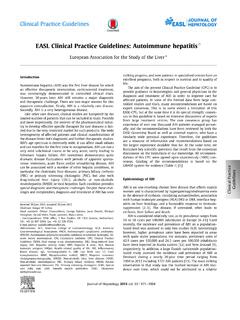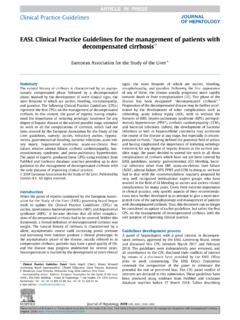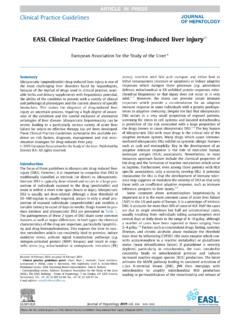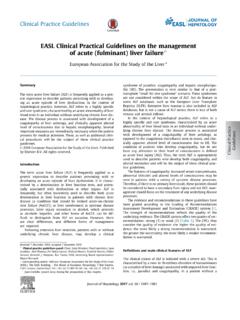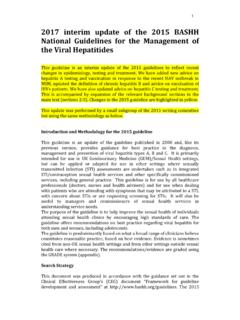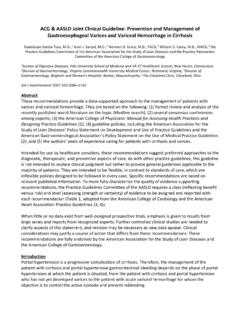Transcription of EASL Clinical Practice Guidelines on the management of ...
1 EASL Clinical Practice Guidelines on the management of benignliver tumoursqEuropean Association for the Study of the Liver (EASL) IntroductionBenign liver tumours are a heterogeneous group of lesions withdifferent cellular origins, as summarized by an internationalpanel of experts sponsored by the World Congress ofGastroenterology in 1994[1]. These lesions are frequently foundincidentally as a consequence of the widespread use of imagingtests and often have a benign course. Some of these lesions areof greater Clinical relevance than others, and the aim of these rec-ommendations is to provide a contemporary aid for the practicaldiagnosis and management of the more common benigntumours.
2 These include haemangiomas, focal nodular hyperplasia(FNH) and hepatocellular adenoma (HCA).The evidence and recommendations in these Guidelines havebeen graded according to the grading of the recommendationsassessment development and evaluation (GRADE) system[2].The strength of recommendations reflects the quality of underly-ing evidence. The GRADE system offers two grades of recommen-dation: strong (1) or weak (2) (Table 1). The Clinical practiceguidelines thus consider the quality of evidence: the higher thequality of evidence, the more likely a strong recommendation iswarranted; the greater the variability in values and preferences,or the greater the uncertainty, the more likely a weaker recom-mendation is management of a liver nodule Liver nodules are often identified initially on an abdominal ultra-sound scan (US).
3 An US may be performed to investigate a symp-tom, such as abdominal pain or weight loss, a sign such ashepatomegaly, a finding such as abnormal liver function tests,or possibly an unrelated condition ( , a urinary tract infection).Current patient history should cover the presenting complaintand past medical history and should determine whether the indi-vidual has any condition associated with the development of liverlesions. These may include a previous cancer or constitutionalsymptoms (anorexia, weight loss, asthenia) or fever which maypoint to malignancy or an infection.
4 A history of foreign travelor dysentery may be important if an amoebic abscess is sus-pected. A systemic enquiry should explore if there are symptomsor signs to support a primary malignancy elsewhere, such asaltered bowel habit, a breast lump or a skin lesion. A medicationhistory is always important, but in the context of a liver lump should specifically establish use of oral contraceptive pills (OCPs).In addition, direct questioning should identify any risk factors forchronic liver disease or cancer.
5 These include a known history ofviral hepatitis or cirrhosis, history of transfusion, tattoos, intra-venous drug abuse, family history of liver disease or liver tumour,alcohol excess, smoking, features of the metabolic syndrome(obesity, type 2 diabetes mellitus, hypertension, cardiovasculardisease) and a drug history, which may identify those such asmethotrexate, tamoxifen or examination and baseline investigations, whichshould aim to exclude underlying chronic liver disease, contrastenhanced (CE) imaging for tumour characterization is indicated,with options including CE ultrasound (CEUS), computer tomogra-phy (CT) and magnetic resonance imaging (MRI).
6 If cancer is sus-pected, a CT scan would provide a rapid assessment and is widelyavailable. MRI may take longer and induces more anxiety in indi-viduals with claustrophobia, but unlike CT, does not use ionizingradiation. Based on the water content and magnetic properties,MRI provides a more detailed assessment of tissues. MRI is there-fore preferable as a first line assessment when a benign lesion issuspected, especially in a young individual. In association with anunremarkable baseline history, examination and blood tests,imaging is frequently sufficient to establish a diagnosis of abenign liver tumour and inform subsequent management deci-sions.
7 It is important, however, not to misdiagnose a there is significant doubt, biopsy or resection may be appropri-ate. However, these are invasive procedures associated with riskand should only be pursued after consideration by an experi-enced multidisciplinary team (MDT).Journal of Hepatology2016vol. 65j386 398 Received 5 April 2016; accepted 5 April 2016qClinical Practice Guideline Panel:Massimo Colombo (Chairman), AlejandroForner, Jan Ijzermans, Val rie Paradis, Helen Reeves, Val rie Vilgrain, JessicaZucman-Rossi.
8 Corresponding author. Address: European Association for the Study of the Liver(EASL), The EASL Building Home of European Hepatology, 7 rue Daubin, CH1203 Geneva, Switzerland. Tel.: +41 (0) 22 807 03 60; fax: +41 (0) 22 328 07 Practice GuidelinesThe team should be one with expertise in the management of benign liver lesions and should include a hepatologist, a hepatobiliary surgeon, diagnostic and interventional radiologists and a pathologist. Each member of the team must hold specific and relevant training, expertise and experience relevant to the management of benign liver lesions.
9 The team should be one with the skills required not only to appropriately manage these patients, but also manage the rare but known complications of diagnostic or therapeutic interventions. The benign liver tumour multidisciplinary teamFor each of the common benign lesions, this guideline willinclude a summary of epidemiological data, pathology, patho-physiology and natural progression, radiological features anddiagnostic criteria, as well as recommendations for haemangiomasEpidemiologyHepatic haemangiomas are the most common primary livertumours.
10 Haemangiomas are present in 20% of the generalpopulation, and are typically discovered incidentally during eval-uation of non-specific abdominal complaints[3 5]. The preva-lence of haemangiomas is generally estimated to be around 5%in imaging series[6], but has been reported as high as 20% inautopsy series[4,7]. Haemangioma can be diagnosed in all agegroups but are more frequently diagnosed in women between30 50 years. Reported female to male gender ratios are variable,ranging from as low as :1 and as high as 6:1[7].




